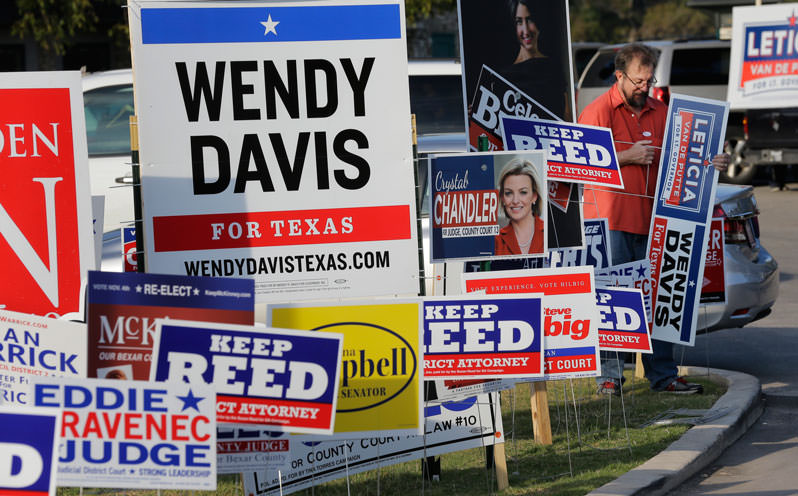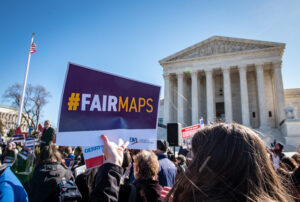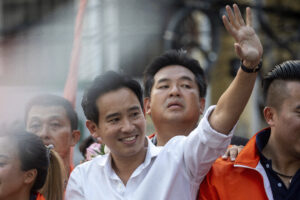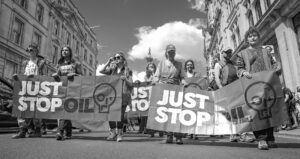Is Voter Suppression an American Tradition?
Today's ID laws are driven by an old purpose—undermining genuine majority rule and deflecting threats to the established order. A campaign worker places a sign outside an early voting site in San Antonio. The U.S. Supreme Court earlier this month gave Texas permission to enforce a contested voter ID law in the coming election. AP/Eric Gay
A campaign worker places a sign outside an early voting site in San Antonio. The U.S. Supreme Court earlier this month gave Texas permission to enforce a contested voter ID law in the coming election. AP/Eric Gay
As midterm elections loom, voter suppression schemes are sweeping the land, with new requirements on voter identification leading the way and getting the lion’s share of attention. Anyone interested in fair elections should be concerned and alarmed.
But are the new ID requirements really all that novel? Or are they better understood as the revival of a longstanding tradition evident from the nation’s earliest days, designed to restrict the franchise and manipulate outcomes?
Before answering those questions, let’s take a closer look at the current voter ID landscape. The National Conference of State Legislatures, which keeps statistical track of such matters, has reported that 34 states have enacted laws mandating that voters produce identification documents at the polls. To date, only three such laws have been blocked—those enacted in Pennsylvania and Arkansas by state courts and the Wisconsin scheme by the U.S. Supreme Court. A fourth voter ID law—in North Carolina — isn’t slated to go into effect until 2016.
The remaining 30 ID laws will be in place for the midterms, including those in seven states (Georgia, Indiana, Kansas, Mississippi, Tennessee, Texas and Virginia) that strictly require current government-issued photo IDs. According to the Brennan Center for Justice, prior to the 2006 elections no state had compelled its voters to produce such credentials in order to cast ballots, although some, like Hawaii, authorized poll workers to request but not order voters to display some form of identification.
What’s behind the new voter ID surge is no secret. As Supreme Court Justice Ruth Bader Ginsburg has written of the Texas scheme that she unsuccessfully tried to enjoin and as Judge Richard Posner of the 7th Circuit Court of Appeals has observed of the Wisconsin plan, voter ID laws are the contemporary equivalent of the poll taxes of the Jim Crow era, which were outlawed by the 24th Amendment in 1964.
Like the old poll taxes, Ginsburg and Posner explain, the new ID laws target minority voters, who are typically among the most liberal, and who are also often the least able to pay for IDs or meet the costs involved in traveling to the DMV or other government offices to obtain them. And like the old poll taxes, the new ID laws do nothing to ensure the integrity of elections. As numerous studies have shown, in-person voter fraud is virtually nonexistent. The new ID movement thus offers a false solution to a trumped-up problem.
While Ginsburg has long been skeptical of voter ID requirements and sided with the minority in the Supreme Court’s 2008 decision that validated Indiana’s voter ID law (Crawford v Marion County), Posner is a recent convert to the anti-ID judicial community. Indeed, he was the author of the original 7th Circuit opinion that the Supreme Court upheld in the Crawford case. Now, he is one of the most eloquent critics of both the Crawford ruling and the Supreme Court’s 2013 decision in Shelby County v. Holder, which gutted the Voting Rights Act. But as forceful as Ginsburg and the repentant Posner are in their recent opinions on the Texas and Wisconsin voter ID laws, neither lays out the full historical context or political dimensions of voter suppression.
Notwithstanding the landmark advances achieved in the immediate aftermath of the Civil War, the adoption in 1920 of the 19th Amendment according women the right to vote in federal elections, and the passage of the Voting Rights Act in 1965, voter suppression has been the norm for much of our history. From the original disenfranchisement of black slaves and women to the early exclusions of white men without property, voter inclusion has always been an elusive goal.
Current voter ID laws and other suppression techniques aimed at limiting early voting and same-day registration may be less obvious than the poll taxes, whites-only primaries and literacy tests of yesteryear, but they are driven by the same purpose of undermining genuine majority rule and deflecting potential threats to the established order. If anything, today’s techniques are all the more insidious precisely because they are less obvious.
Today’s suppression schemes are also more dangerous because they have been accompanied by a series of Supreme Court decisions that have unleashed the power of corporations and the wealthy to spend unlimited money on elections (the Citizens United opinion and its progeny) while restricting the right of public-sector unions—the last bastion of organized labor in America—to collect the membership dues and fair-share fees they need to exist. All of these developments—voter suppression, the removal of limits on campaign spending, and union busting — are joined synergistically in what I have previously called in this column a “trifecta of institutionalized class domination.”
Whether the trifecta is anything truly new or simply the latest version of a longstanding tradition I will leave for you to decide as the midterms approach and you contemplate how to vote or even whether you will head to the polls at all, given the lack of real political alternatives on the ballot.
Your support matters…Independent journalism is under threat and overshadowed by heavily funded mainstream media.
You can help level the playing field. Become a member.
Your tax-deductible contribution keeps us digging beneath the headlines to give you thought-provoking, investigative reporting and analysis that unearths what's really happening- without compromise.
Give today to support our courageous, independent journalists.






You need to be a supporter to comment.
There are currently no responses to this article.
Be the first to respond.